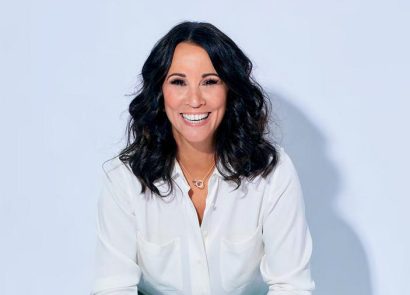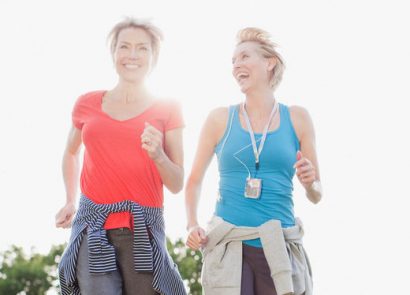Since the pandemic bowled in and disrupted everything from your job to how you work out, attitudes to health and fitness have changed fairly drastically. Case in point: millennials are now favouring treadmill sprints over pub-poured spirits, with 80 percent* of them more likely to meet a friend in the gym than the bar down the road. What’s more, research from Nuffield Health found that over half of Brits took up a new form of exercise during the first lockdown in March – some of whom might not have felt comfortable or even welcome in a fitness space before working out from home was a thing. Don’t get us wrong, more people getting active is undoubtedly good news, so as gyms begin to get back to somewhat normal, do those fitness spaces still lack inclusivity? H&W steps inside the gyms striving for change and learns from the affirming trainers that exercise really is for everyone.
Discomfort zone
After months of live workouts and training in the comfort of your own home, it’s no surprise that returning to a gym environment can provoke some anxious feelings, some of which can make you not want to return or do a 180 and retreat. The notion of being anxious about entering or joining a gym has been given the umbrella term of ‘gymtimidation’, and is something that resident SHREDDY personal trainer Lianna Swan (shreddy.com) feels is more prevalent in women than men. She says that the boom in free, online classes has made people still feel uncomfortable in gyms – now that they’re open again – and understands that certain areas of the space can be intimidating. “I’ve definitely noticed a big difference between training men and women, especially when they‘re entering the gym for the first time. For women, especially the younger clients, I always ask how they feel about entering the main weight section ahead of training there. The reason being that I’m aware they’ve probably never stepped in there before and I know that it can be seriously intimidating.”
Strong connection
The uptake in health and fitness apps was well documented in the fallout of 2020’s first lockdown, too. Specifically, Couch to 5k (the app that coaches running novices on their journey to reach the 5k distance), was downloaded one million times by July, and Joe Wicks is estimated to have made more than £32m* from his new app, The Body Coach. This phenomenon of virtual training is what prompted Jessica Redman to find her wellness platform Work That (workthat. co.uk). As somebody in the LGBTQ community, Jessica is no stranger to that feeling of gymtimidation and quickly felt excluded after training in places that had “little to no diversity. I realised that gym spaces catered predominantly to cis-gendered, muscly men. I attended the gym with my girlfriend and introduced her to a group of personal trainers in the gym. I’d got to know them quite well and really didn’t expect their utter surprise and questioning of my relationship the next time I went training. This is when I considered online as an option for people who don’t like gym environments and can get sweaty without worry.”
Exercise for enjoyment
Gyms have been open for a few months now and trends are beginning to emerge that weren’t there pre-pandemic. Those who previously may have felt like they didn’t belong in fitness spaces revelled in the access to home workouts which meant they weren’t being watched by others in the gym. Stress and anxiety were also heightened through the pandemic, meaning that exercise was an outlet to soothe ourselves from the throws of the situation and the typical weight-loss goal was pretty scarce. Fitness trainer, Eni Adeyemo (she’s @enicoreblimey on Instagram), has found that aesthetics is no longer the primary focus. “More people are trying new things, such as skating, skipping or just being more consistent with activities they love doing. Clients still come to me for the usual goals of getting into shape, but now, the need and desire to have a stronger and fitter body has been amplified.”
A weighty issue
Like with a lot of things though, there’s still room for improvement. Of all the trainers H&W asked for this feature, 100 percent of them said that gyms need to take action to be more inclusive and welcoming. Personal trainer Lavina Mehta MBE, who started doing online workouts for the elderly, disabled and vulnerable during lockdown, believes that more classes should be offered for all abilities and ages. “I was so keen to help those who might have been isolated or less mobile during the pandemic, especially as there’s quite a lot of misunderstanding about exercise in the South Asian community. Virtual training has meant that the barriers to work out – time, motivation and convenience – have been broken down, and one of my main messages is that you’re never too late to start.”
Like the other PTs we spoke to, Lavina aims to make her clients feel as comfortable as possible when they train with her and still has this at the top of her priority list. “Even if it’s just going live [on Instagram] when I’m heading over to the weights section, I want to make my clients feel like they’re safe and are supported within that space.” The same goes for Eni. To make the people she trains feel like they belong is ultimately by throwing them in the deep end. “Most women are not used to lifting weights, so when I take on a new client, I will take them over to [that section of the gym] so they’re familiar with it. Even if they’re lifting the lightest weights on the rack, it will make a big difference to them mentally.”
Going the extra mile
With this in mind, workout spaces are faced with new challenges, which Lianna thinks should be seen as an opportunity. With some people just starting their fitness journey or experimenting with new ways of exercising, gyms now have the chance to tap into a demographic who weren’t particularly interested in signing up prepandemic. “It’s really nice for gyms to take their place as a centre for the community, as there are so many people who see the gym as a release. They can meet people there; they know the regular PTs and those that train at similar times to them. It’s so great that gyms can maximise on this, and I think they should be doing this as much as possible. Whether that’s a regular coffee morning, a gym community fitness competition or games – that will help build a sense of community and make it open to all.” A workout can be hard enough without the added pressure of feeling insecure or unwelcome, and as exercise continues to be an outlet for stress relief or for pure enjoyment, the more gyms that are able to facilitate this the better.
Speak out
Keen for some action to be taken at your gym? Jessica’s tips can give you some confidence to asking the right questions
• You can check if the gym has stairs or lifts. If there aren’t any, you can ask the staff if they have ramps to help less able bodied members into the gym area.
• There’s always the option to send constructive feedback via email. You don’t have to take a hard approach; you can simply ask if the employees at the gym have considered how they can better represent a wide range of clients.
• Check out your gym’s social media and see if they represent a wide range of people. If not, pop them a DM and suggest ways they can connect with a wider audience of people. For example, more diverse bodies, Black and ethnic minorities or posts explaining that the gym is accessible for people who use wheelchairs.
• If you’re taking part in a conversation or class and you hear something upsetting, speak up and ask if others heard the same thing. There’s power in numbers and you can approach the gym manager to explain that you felt uncomfortable. An example of this could be ‘let’s get you beach body ready!‘ or a discriminatory comment.
• Do you attend classes or know people in the gym? Start up a conversation and ask them if they’ve noticed a lack of representation. You play an important role by being a member because you access the space regularly, so planting the seed is a great way to get others thinking.




















